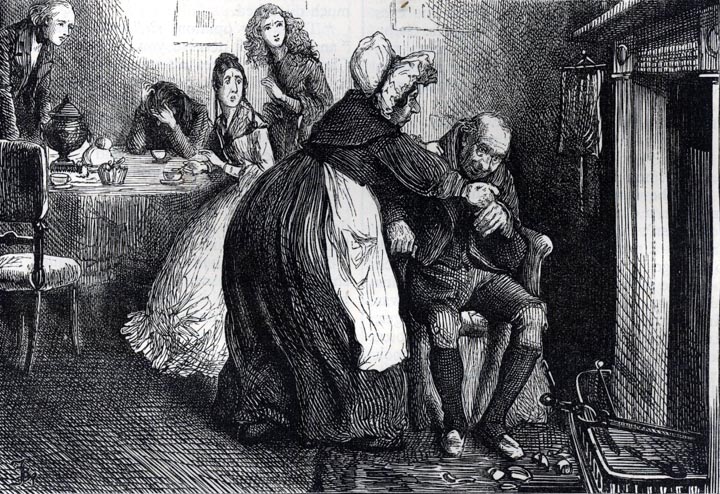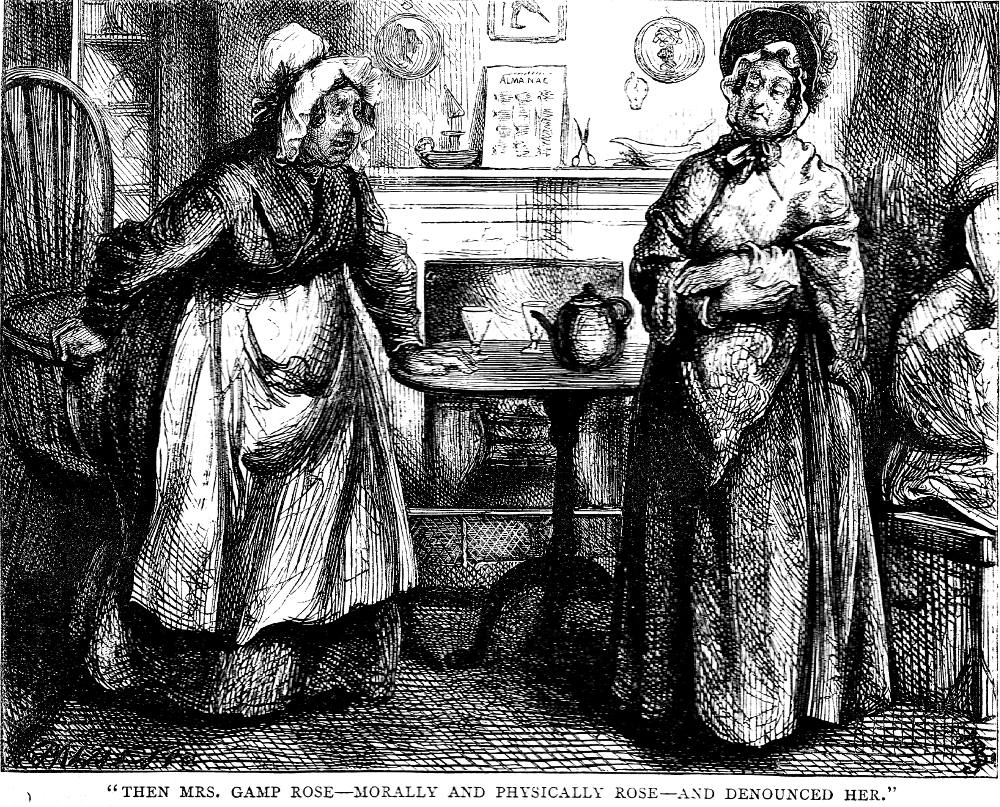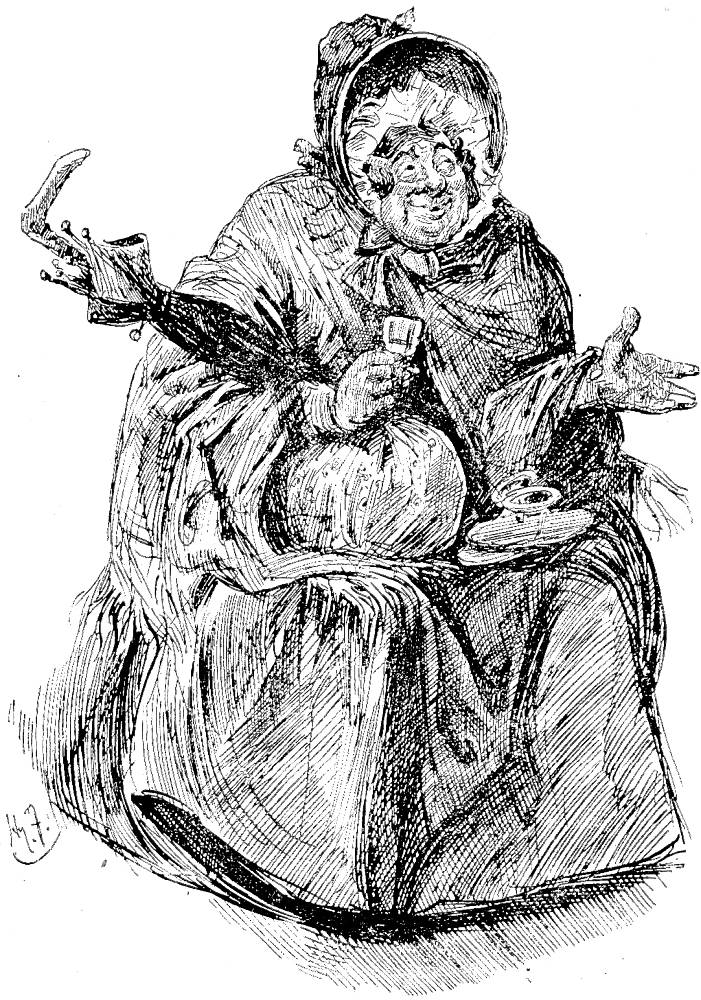
The scene which Copping in his post-Victorian Character Sketches from Dickens (1924) has chosen to exemplify the comedic aspect of the picaresque novel Martin Chuzzlewit, Sairey Gamp and Betsey Prig, occurs in what was originally episode eighteen (Chapter 49, "In Which Mrs. Harris, Assisted by a Teapot, is the Cause of a Division Between Friends," June 1844). Compare Copping's more realistic handling of his materials to Phiz's version of the boozey nurse in Mrs. Gamp Propoges a Toast (June 1844). Gone are the lovingly realized background details from Phiz such as Sairey's additional outfits hanging above the friends who are about to experience a falling-out over the existential issue that governs Sairey's whole existence: the reality of Mrs. Harris.
In one of his prefaces to Martin Chuzzlewit, Dickens declares that his main object was "to exhibit in a variety of aspects the commonest of all vices; to show how selfishness propagates itself; and to what a grim giant it may grow, from small beginnings." In the person of Pecksniff he created a character that has become a by-word for hypocrisy, whilst other characters, such as Sairey Gamp and old Martin Chuzzlewit, have taken their place in the gallery of immortals. On the reverse side, equally inimitable, are to be found Tom Pinch, Mark Tapley, Ruth Pinch, John Westlock, and scores of others. The selections made from the book represent these phases. Old Martin is introduced in the first excerpt, delightful Ruth Pinch and her brother in the next, whilst the immortal tea party of Sairey Gamp and Betsy Prig forms the third. [Matz 68]
Margaret Cardwell suggests in her introduction to the World's Classics edition of the novel (1984) that "The reader wants Mrs. Gamp and Mr. Pecksniff to survive for ever, perpetually exhibiting the resilience which is theirs" (xiii). This derivative illustration (unlike the Phizzian originals) fulfills the reader's desire for a quintessential image of the indefatigable private sick-room nurse, although Copping has based his florid lithograph on Phiz's original June 1844 engraving Mrs. Gamp Propoges a Toast. Copping would have been well aware that this captioned illustration for Chapter XLIX, "In Which Mrs. Harris, Assisted by a Teapot, is the Cause of a Division between Friends," Part 18, marks a turning point in the relationship between the two nurses; as the serial novel drew to its poetically just conclusion, Dickens created a sharp falling out between the nursing and tippling confederates.

No. 24 SAIREY GAMP (Martin Chuzzlewit.)
The greatest of all Dickens' great creations; an old-time "nurse," with an equal relish for "a lying-in" [childbirth] or a [dressing a corpse] laying-out;" a fat old woman with a husky voice and a moist eye, and one "whose society it is difficult to enjoy without becoming conscious of a smell of spirits." She has a phantom friend — a Mrs. Harris — and prefers the bottle to be "left on the chimbley-piece" at her own "dispogal." [John Player's "Characters from Dickens, No. 24"]
Although Dickens originally aligned the boozy Sairey with the novel's deceivers and hypocrites, the voluble alcoholic grew beyond that original orientation in the minds and hearts of the Victorian novel-reading public. She became over the course of fifty chapters an endearing, comedic figure. Although the novelist must have felt the necessity to expose Mrs. Harris as a product of Sairey's fecund imagination and verbal creativity, one senses that Dickens could not bring himself to explode Mrs. Harris's inventor. Despite her considerable bulk, alcohol-slurred discourse, and obvious humbug, Sairey Gamp is akin to her thirty-four-year-old story-teller, Dickens, because she, too, has constructed a character for her own satisfaction and self-affirmation. Her fictive friend, Mrs. Harris, exists primarily for the sake of advertisement, at least in Sairey's mind. She provides Sairey with countless testimonials to the calibre of her friend's sick-room ministrations to those leaving this world — as well as to those entering it. Thus, Dickens the story-teller puts his reader in the odd position of ardently hoping to see Mrs. Harris dispatched as a Dickensian Bunbury, on the one hand, but also sentimentally convinced that Sairey should be left, psychologically speaking, intact.
Sairey Gamp in Dickens's Martin Chuzzlewit (1843-1910)
Although originally intended to be just a bit part, like a ham actor, a mere butt of Dickens's satire of drunken, disreputable nurses, Sairey consistently upstages the story's principals in whatever edition she appears. Although she does not "develop" as a character, she certainly blossoms, becoming more human and more relatable after Phiz's three representations of her. We can see her not merely "fleshed out" but humanized in Fred Barnard's Household Edition representation of her. Although he has, according to the caption, seated her in the undertaker Mr. Mould's parlour in Mrs. Gamp, on the Art of Nursing (Chapter XXV), Barnard has situated her in her comfortable "chimley" corner. The realist illustrator of the sixties crams into his study almost every visual detail associated with the bleery-eyed, husky-voiced, androgynous figure of capacious dimensions: the short, thick neck; the round face; the swollen nose (so forcibly anticipating that of W. C. Fields as the quintessence of the inveterate tippler); rusty black gown stained by snuff; oversize bonnet; bottle stationed on the mantelpiece; and, of course, her conspicuous umbrella or "gamp" from which she derives her surname.
Related Materials: Later Illustrations of the Novel
- Mrs. Gamp: The Genesis of the Divine Sairey
- The Divine Sairey Gamp: Not a Character, but An Enduring Comic Masterpiece
- Illustrations by Sol Eytinge, Jr. (16 plates from the Ticknor and Fields' Diamond Edition of 1867)
- Fred Barnard (60 plates from the Chapman and Hall Household Edition of 1872)
- Clayton J. Clarke (of the five studies from three sources, 1910, two are of Sairey Gamp)
- Harry Furniss (twenty-eight lithographs for the Charles Dickens Library Edition, 1910)
Scanned images, formatting, and text by Philip V. Allingham. [You may use these images without prior permission for any scholarly or educational purpose as long as you (1) credit the person who scanned the image and (2) link your document to this URL in a web document or cite the Victorian Web in a print one.]
Bibliography
Allingham, Philip V. "Phiz Illustrations, Parts One through Four." The Dickens Magazine: Martin Chuzzlewit. Series 5. Haslemere, England: Euromed Publications, 2008-2009.
Bentley, Nicolas, Michael Slater, and Nina Burgis. The Dickens Index. New York and Oxford: Oxford U. P., 1990.
Cardwell, Margaret. "Introduction." Charles Dicklens's The Life and Adventures of Martin Chuzzlewit: His Relatives, Friends, and Enemies; Comprising All His Wills and His Ways: With an Historical Record of What He Did, and What He Didn't: Showing, Moreover, Who Inherited the Family Plate, Who Came in for the Silver Spoons, and Who for the Wooden Ladles. The Whole Forming a Complete Key to the House of Chuzzlewit. Edited by Boz. With Illustrations by "Phiz" (1843-44). Oxford and New York: Oxford U. P., 1984. Pp. vii-xv.
Dickens, Charles. The Dickens Souvenir Book. Household Edition. London: Chapman and Hall, 1871-1880. The copy of The Dickens Souvenir Book from which these pictures were scanned is in the collection of the Main Library of The University of British Columbia, Vancouver, B. C.
Dickens, Charles. The Life and Adventures of Martin Chuzzlewit. Illustrated by Hablot Knight Browne. London: Chapman and Hall, 1844.
__________. The Life and Adventures of Martin Chuzzlewit. Illustrated by Sol Eytinge, Junior. The Diamond Edition. Boston: Ticknor and Fields, 1867.
__________. The Life and Adventures of Martin Chuzzlewit. Illustrated by Fred Barnard. The Household Edition. 22 vols. London: Chapman and Hall, 1872. Vol. 2.
__________. Life and Adventures of Martin Chuzzlewit. Illustrated by Harry Furniss. The Charles Dickens Library Edition. 18 vols. London: Educational Book, 1910. Vol. 7.
__________. Martin Chuzzlewit. Works of Charles Dickens. Household Edition. 55 vols. Illustrated by F. O. C. Darley and John Gilbert. New York: Sheldon and Co., 1863. Vols. 1 to 4.
__________. The Life and Adventures of Martin Chuzzlewit. Illustrated by Sol Eytinge, Junior. The Diamond Edition. Boston: Ticknor and Fields, 1867.
__________. The Life and Adventures of Martin Chuzzlewit. Illustrated by Fred Barnard. The Household Edition. 22 vols. London: Chapman and Hall, 1872. Vol. 2.
_____. Life and Adventures of Martin Chuzzlewit. Illustrated by Harry Furniss. Edited by J. A. Hammerton. The Charles Dickens Library Edition. 18 vols. London: Educational Book, 1910. Vol. 7.
Guerard, Albert J. "Martin Chuzzlewit: The Novel as Comic Entertainment." The Triumph of the Novel: Dickens, Dostoevsky, Faulkner. Chicago & London: U. Chicago P., 1976, 235-60.
Hammerton, J. A. Ch. 15, "Martin Chuzzlewit." The Dickens Picture-Book: A Record of the Dickens Illustrations with 600 Illustrations and a Frontispiece by Harry Furniss. The Charles Dickens Library Edition. 18 vois. London: Educational Book, 1910. XVII, 266-93.
Kyd [Clayton J. Clarke]. Characters from Dickens. Nottingham: John Player & Sons, 1910.
"Martin Chuzzlewit — Fifty-nine Illustrations by Fred Barnard." Scenes and Characters from the Works of Charles Dickens, Being Eight Hundred and Sixty-six Drawings by Fred Barnard, Gordon Thomson, Hablot Knight Browne (Phiz), J. McL. Ralston, J. Mahoney, H. French, Charles Green, E. G. Dalziel, A. B. Frost, F. A. Fraser, and Sir Luke Fildes. London: Chapman and Hall, 1907.
Matz, B. W., and Kate Perugini; illustrated by Harold Copping. Character Sketches from Dickens. London: Raphael Tuck, 1924. Copy in the Paterson Library, Lakehead University, Thunder Bay, ON.
Steig, Michael. "III. From Caricature to Progress: Master Humphrey's Clock and Martin Chuzzlewit." Dickens and Phiz. Bloomington & London: Indiana U. P., 1978, 51-85.
__________. "Martin Chuzzlewit's Progress by Dickens and Phiz." Dickens Studies Annual 2 (1972): 119-49.
Vann, J. Don. Victorian Novels in Serial. New York: Modern Language Association, 1985.
Created 14 November 2024














